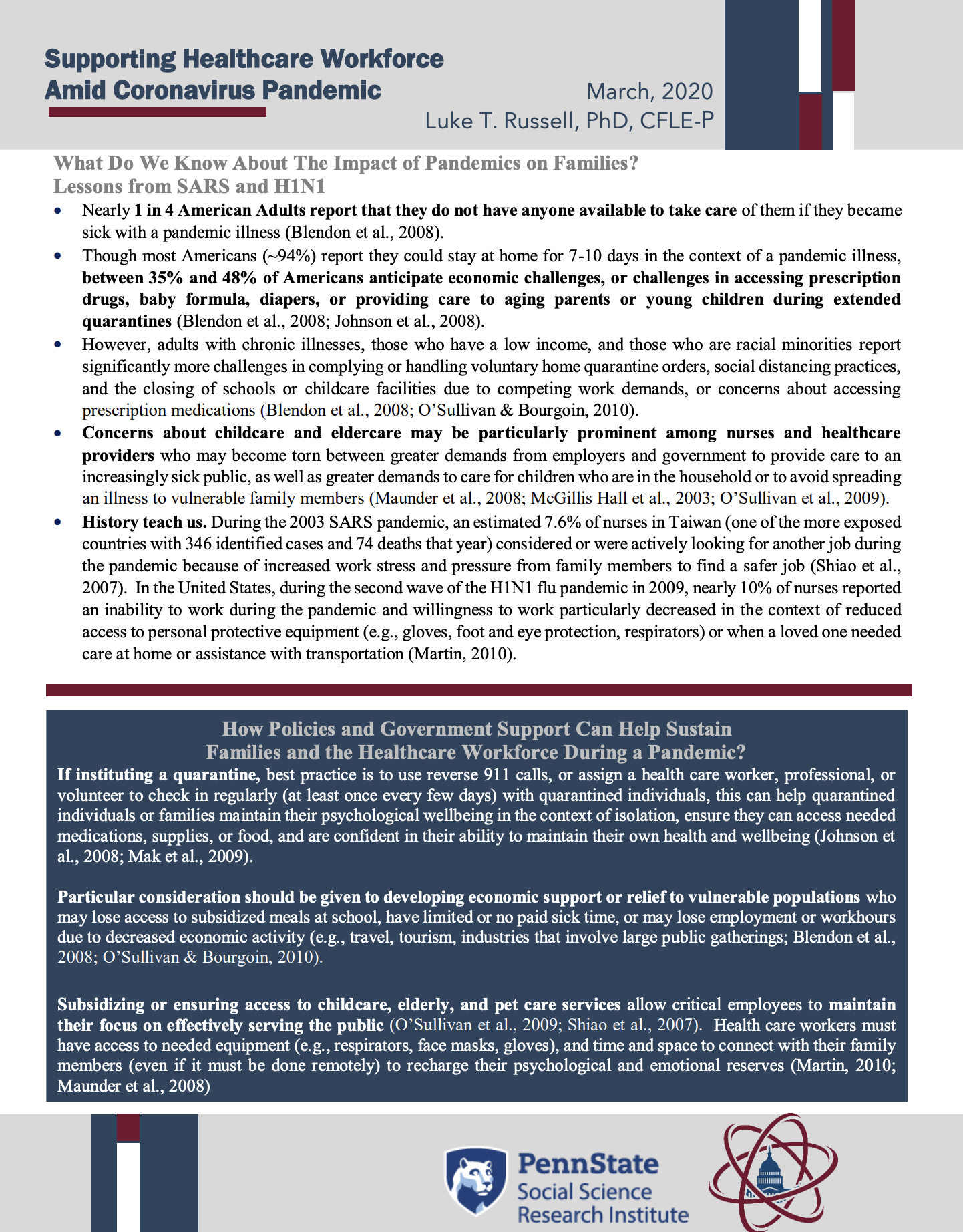
What Do We Know About The Impact of Pandemics on Families?
Lessons from SARS and H1N1
- Nearly 1 in 4 American Adults report that they do not have anyone available to take care of them if they became sick with a pandemic illness (Blendon et al., 2008).
- Though most Americans (~94%) report they could stay at home for 7-10 days in the context of a pandemic illness, between 35% and 48% of Americans anticipate economic challenges, or challenges in accessing prescription drugs, baby formula, diapers, or providing care to aging parents or young children during extended quarantines (Blendon et al., 2008; Johnson et al., 2008).
- However, adults with chronic illnesses, those who have a low income, and those who are racial minorities report significantly more challenges in complying or handling voluntary home quarantine orders, social distancing practices, and the closing of schools or childcare facilities due to competing work demands, or concerns about accessing prescription medications (Blendon et al., 2008; O’Sullivan & Bourgoin, 2010).
- Concerns about childcare and eldercare may be particularly prominent among nurses and healthcare providers who may become torn between greater demands from employers and government to provide care to an increasingly sick public, as well as greater demands to care for children who are in the household or to avoid spreading an illness to vulnerable family members (Maunder et al., 2008; McGillis Hall et al., 2003; O’Sullivan et al., 2009).
- History can teach us. During the 2003 SARS pandemic, an estimated 7.6% of nurses in Taiwan (one of the more exposed countries with 346 identified cases and 74 deaths that year) considered or were actively looking for another job during the pandemic because of increased work stress and pressure from family members to find a safer job (Shiao et al., 2007). In the United States, during the second wave of the H1N1 flu pandemic in 2009, nearly 10% of nurses reported an inability to work during the pandemic and willingness to work particularly decreased in the context of reduced access to personal protective equipment (e.g., gloves, foot and eye protection, respirators) or when a loved one needed care at home or assistance with transportation (Martin, 2010).
How Policies And Government Support Can Help Sustain Families And The Healthcare Workforce During A Pandemic?
If instituting a quarantine, best practice is to use reverse 911 calls (automated calls from local public safety authorities), or assign a health care worker, professional, or volunteer to check in regularly (at least once every few days) with quarantined individuals, this can help quarantined individuals or families maintain their psychological wellbeing in the context of isolation, ensure they can access needed medications, supplies, or food, and are confident in their ability to maintain their own health and wellbeing (Johnson et al., 2008; Mak et al., 2009).
Particular consideration should be given to developing economic support or relief to vulnerable populations who may lose access to subsidized meals at school, have limited or no paid sick time, or may lose employment or workhours due to decreased economic activity (e.g., travel, tourism, industries that involve large public gatherings; Blendon et al., 2008; O’Sullivan & Bourgoin, 2010).
Subsidizing or ensuring access to childcare, elderly, and pet care services allow critical employees to maintain their focus on effectively serving the public (O’Sullivan et al., 2009; Shiao et al., 2007). Health care workers must have access to needed equipment (e.g., respirators, face masks, gloves), and time and space to connect with their family members (even if it must be done remotely) to recharge their psychological and emotional reserves (Martin, 2010; Maunder et al., 2008)
End Notes / References
Blendon, R. J., Koonin, L. M., Benson, J. M., Cetron, M S., Pollard, W. E., Mitchell, E. W., Weldon, K. J., & Hermann, M. J. (2008). Public response to community mitigation measures for pandemic influenza. Emerging Infectious Diseases, 14(5), 778-786. https://doi.org/10.3201/eid1405.071437
Johnson, A. J., Moore, Z. S., Edelson, P. J., Kinnane, L., Davies, M., Shay, D. K., Balish, A., McCarron, M., Blanton, L., Finelli, L., Averhoff, F., Bresee, J., Engel, J., & Fiore, A. (2008). Household responses to school closure resulting from outbreak of Influenza B, North Carolina. Emerging Infectious Diseases, 14(7), 1024-1030. https://doi.org/10.3201/eid1407.080096
Mak, W. W. S., Law, R. W., Woo, J., Cheung, F. M., & Lee, D. (2009). Social support and psychological adjustment to SARS: The mediating role of self-care self-efficacy. Psychology and Health, 24(2), 161-174. https://doi.org/10.1080/08870440701447649
Martin, S. D. (2011). Nurses’ ability and willingness to work during pandemic flu. Journal of Nursing Management, 19(1), 98-108. https://doi.org/10.1111/j.1365-2834.2010.01190.x
Maunder, R. G., Leszcz, M., Savage, D., Adam, M. A., Peladeau, N., Romano, D., Rose, M., & Schulman, B. (2008). Applying the lessons of SARS to pandemic influenza: An evidence-based approach to mitigating the stress experienced by healthcare workers. Canadian Journal of Public Health, 99, 486-488. https://doi.org/10.1007/BF03403782
McGillis Hall, L., Angus, J., Peter, E., O’Brien-Pallas, L., Wynn, F., & Donner, G. (2003). Media portrayal of nurses’ perspectives and concerns in the SARS crisis in Toronto. Journal of Nursing Scholarship, 35(3), 211-216. https://doi.org/10.1111/j.1547-5069.2003.00211.x
O’Sullivan, T., & Bourgoin, M. (2010). Vulnerability in an influenza pandemic: Looking beyond medical risk. Public Health Agency of Canada.
O’Sullivan, T. L., Amaratunga, C., Phillips, K. P., Corneil, W., O’Connor, E., Lemyre, L., & Dow, D. (2009). If schools are closed, who will watch our kids? Family caregiving and other sources of role conflict among nurses during large-scale outbreaks. Prehospital and Disaster Medicine, 24(4), 321-325. https://doi.org/10.1017/S1049023X00007044
Shiao, J. S., Koh, D., Lo, L., Lim, M., & Guo, Y. L. (2007). Factors predicting nurses’ consideration of leaving their job during the SARS outbreak. Nursing Ethics, 14(1), 5-17. https://doi.org/10.1177/0969733007071350
The Research-to-Policy Collaboration (RPC) works to bring together research professionals and public officials to support evidence-based policy. Please visit their website to learn more.
Key Information
RPC Website
Research-to-Policy Collaboration
Publication DateMarch 1, 2020
Topic Area(s)Health
Resource TypeWritten Briefs
Share This Page
What Do We Know About The Impact of Pandemics on Families?
Lessons from SARS and H1N1
- Nearly 1 in 4 American Adults report that they do not have anyone available to take care of them if they became sick with a pandemic illness (Blendon et al., 2008).
- Though most Americans (~94%) report they could stay at home for 7-10 days in the context of a pandemic illness, between 35% and 48% of Americans anticipate economic challenges, or challenges in accessing prescription drugs, baby formula, diapers, or providing care to aging parents or young children during extended quarantines (Blendon et al., 2008; Johnson et al., 2008).
- However, adults with chronic illnesses, those who have a low income, and those who are racial minorities report significantly more challenges in complying or handling voluntary home quarantine orders, social distancing practices, and the closing of schools or childcare facilities due to competing work demands, or concerns about accessing prescription medications (Blendon et al., 2008; O’Sullivan & Bourgoin, 2010).
- Concerns about childcare and eldercare may be particularly prominent among nurses and healthcare providers who may become torn between greater demands from employers and government to provide care to an increasingly sick public, as well as greater demands to care for children who are in the household or to avoid spreading an illness to vulnerable family members (Maunder et al., 2008; McGillis Hall et al., 2003; O’Sullivan et al., 2009).
- History can teach us. During the 2003 SARS pandemic, an estimated 7.6% of nurses in Taiwan (one of the more exposed countries with 346 identified cases and 74 deaths that year) considered or were actively looking for another job during the pandemic because of increased work stress and pressure from family members to find a safer job (Shiao et al., 2007). In the United States, during the second wave of the H1N1 flu pandemic in 2009, nearly 10% of nurses reported an inability to work during the pandemic and willingness to work particularly decreased in the context of reduced access to personal protective equipment (e.g., gloves, foot and eye protection, respirators) or when a loved one needed care at home or assistance with transportation (Martin, 2010).
How Policies And Government Support Can Help Sustain Families And The Healthcare Workforce During A Pandemic?
If instituting a quarantine, best practice is to use reverse 911 calls (automated calls from local public safety authorities), or assign a health care worker, professional, or volunteer to check in regularly (at least once every few days) with quarantined individuals, this can help quarantined individuals or families maintain their psychological wellbeing in the context of isolation, ensure they can access needed medications, supplies, or food, and are confident in their ability to maintain their own health and wellbeing (Johnson et al., 2008; Mak et al., 2009).
Particular consideration should be given to developing economic support or relief to vulnerable populations who may lose access to subsidized meals at school, have limited or no paid sick time, or may lose employment or workhours due to decreased economic activity (e.g., travel, tourism, industries that involve large public gatherings; Blendon et al., 2008; O’Sullivan & Bourgoin, 2010).
Subsidizing or ensuring access to childcare, elderly, and pet care services allow critical employees to maintain their focus on effectively serving the public (O’Sullivan et al., 2009; Shiao et al., 2007). Health care workers must have access to needed equipment (e.g., respirators, face masks, gloves), and time and space to connect with their family members (even if it must be done remotely) to recharge their psychological and emotional reserves (Martin, 2010; Maunder et al., 2008)
End Notes / References
Blendon, R. J., Koonin, L. M., Benson, J. M., Cetron, M S., Pollard, W. E., Mitchell, E. W., Weldon, K. J., & Hermann, M. J. (2008). Public response to community mitigation measures for pandemic influenza. Emerging Infectious Diseases, 14(5), 778-786. https://doi.org/10.3201/eid1405.071437
Johnson, A. J., Moore, Z. S., Edelson, P. J., Kinnane, L., Davies, M., Shay, D. K., Balish, A., McCarron, M., Blanton, L., Finelli, L., Averhoff, F., Bresee, J., Engel, J., & Fiore, A. (2008). Household responses to school closure resulting from outbreak of Influenza B, North Carolina. Emerging Infectious Diseases, 14(7), 1024-1030. https://doi.org/10.3201/eid1407.080096
Mak, W. W. S., Law, R. W., Woo, J., Cheung, F. M., & Lee, D. (2009). Social support and psychological adjustment to SARS: The mediating role of self-care self-efficacy. Psychology and Health, 24(2), 161-174. https://doi.org/10.1080/08870440701447649
Martin, S. D. (2011). Nurses’ ability and willingness to work during pandemic flu. Journal of Nursing Management, 19(1), 98-108. https://doi.org/10.1111/j.1365-2834.2010.01190.x
Maunder, R. G., Leszcz, M., Savage, D., Adam, M. A., Peladeau, N., Romano, D., Rose, M., & Schulman, B. (2008). Applying the lessons of SARS to pandemic influenza: An evidence-based approach to mitigating the stress experienced by healthcare workers. Canadian Journal of Public Health, 99, 486-488. https://doi.org/10.1007/BF03403782
McGillis Hall, L., Angus, J., Peter, E., O’Brien-Pallas, L., Wynn, F., & Donner, G. (2003). Media portrayal of nurses’ perspectives and concerns in the SARS crisis in Toronto. Journal of Nursing Scholarship, 35(3), 211-216. https://doi.org/10.1111/j.1547-5069.2003.00211.x
O’Sullivan, T., & Bourgoin, M. (2010). Vulnerability in an influenza pandemic: Looking beyond medical risk. Public Health Agency of Canada.
O’Sullivan, T. L., Amaratunga, C., Phillips, K. P., Corneil, W., O’Connor, E., Lemyre, L., & Dow, D. (2009). If schools are closed, who will watch our kids? Family caregiving and other sources of role conflict among nurses during large-scale outbreaks. Prehospital and Disaster Medicine, 24(4), 321-325. https://doi.org/10.1017/S1049023X00007044
Shiao, J. S., Koh, D., Lo, L., Lim, M., & Guo, Y. L. (2007). Factors predicting nurses’ consideration of leaving their job during the SARS outbreak. Nursing Ethics, 14(1), 5-17. https://doi.org/10.1177/0969733007071350
The Research-to-Policy Collaboration (RPC) works to bring together research professionals and public officials to support evidence-based policy. Please visit their website to learn more.

Key Information
RPC Website
Research-to-Policy Collaboration
Publication DateMarch 1, 2020
Topic Area(s)Health
Resource TypeWritten Briefs
Share This Page
LET’S STAY IN TOUCH
Join the Evidence-to-Impact Mailing List
Keep up to date with the latest resources, events, and news from the EIC.




